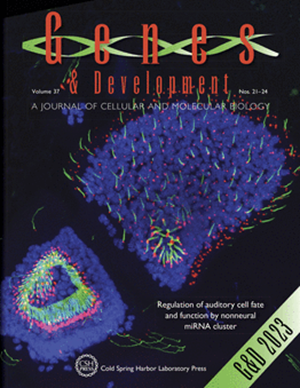人类OAS蛋白的缩合启动多种抗病毒活性,以应对西尼罗病毒
IF 7.7
1区 生物学
Q1 CELL BIOLOGY
引用次数: 0
摘要
低聚腺苷酸合成酶(OASs)是一种古老的蛋白质,在哺乳动物对抗病毒中起着关键作用。已知OAS通过结合病毒dsRNA并合成激活抗病毒核糖核酸内切酶RNase l的2 ' -5 ' -oligo(A)来拮抗病毒复制。在此,我们研究了人类OAS亚型(OAS1、OAS2、OAS3和OASL)在西尼罗病毒(WNV)感染期间的抗病毒活性。我们发现OAS3是激活RNase L所需的主要OAS异构体。OAS3在靠近WNV复制细胞器的dsRNA上的凝聚启动RNase L的激活。OAS3包含三个不同的dsRNA结合域,增强其在dsRNA上的凝聚。OAS3在dsRNA上凝聚的潜力受到dsRNA负载和OAS3表达水平的调节,OAS3可以由I型干扰素组成性表达或诱导。OAS1和OAS2不频繁激活RNase L,因为它们在dsRNA上凝聚的潜力很弱。然而,它们组装成高阶结构,聚集全长ssRNA病毒基因组。OASL不会在dsRNA上凝聚。相反,OASL定位于加工体、应激颗粒和含有宿主和病毒mRNA的RNase l诱导体。这些发现定义了RNase L的激活过程,并阐明了人类OAS蛋白底物和功能的多样性。本文章由计算机程序翻译,如有差异,请以英文原文为准。
Condensation of human OAS proteins initiates diverse antiviral activities in response to West Nile virus
Oligoadenylate synthetases (OASs) are ancient proteins that play a critical role in combatting viruses in mammals. OASs are known to antagonize viral replication by binding viral dsRNA and synthesizing 2′–5′-oligo(A), which activates the antiviral endoribonuclease RNase L. Here, we investigate the antiviral activities of the human OAS isoforms (OAS1, OAS2, OAS3, and OASL) during West Nile virus (WNV) infection. We show that OAS3 is the primary OAS isoform required for activating RNase L. OAS3 condensation on dsRNA proximal to WNV replication organelles initiates RNase L activation. OAS3 contains three distinct dsRNA-binding domains that enhance its condensation on dsRNA. The potential for OAS3 to condense on dsRNA is modulated by dsRNA loads and OAS3 expression level, which can be constitutively expressed or induced by type I interferons. OAS1 and OAS2 do not frequently activate RNase L due to their weak potential to condense on dsRNA. However, they assemble into higher-order structures that aggregate full-length ssRNA viral genomes. OASL does not condense on dsRNA. Instead, OASL localizes to processing bodies, stress granules, and RNase L-induced bodies containing host and viral mRNA. These findings define the process of RNase L activation and elucidate the diversity of substrates and functions of human OAS proteins.
求助全文
通过发布文献求助,成功后即可免费获取论文全文。
去求助
来源期刊

Genes & development
生物-发育生物学
CiteScore
17.50
自引率
1.90%
发文量
71
审稿时长
3-6 weeks
期刊介绍:
Genes & Development is a research journal published in association with The Genetics Society. It publishes high-quality research papers in the areas of molecular biology, molecular genetics, and related fields. The journal features various research formats including Research papers, short Research Communications, and Resource/Methodology papers.
Genes & Development has gained recognition and is considered as one of the Top Five Research Journals in the field of Molecular Biology and Genetics. It has an impressive Impact Factor of 12.89. The journal is ranked #2 among Developmental Biology research journals, #5 in Genetics and Heredity, and is among the Top 20 in Cell Biology (according to ISI Journal Citation Reports®, 2021).
 求助内容:
求助内容: 应助结果提醒方式:
应助结果提醒方式:


